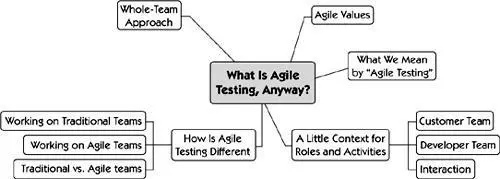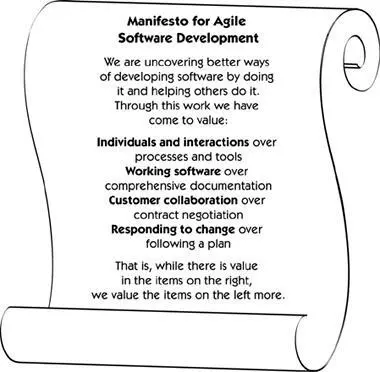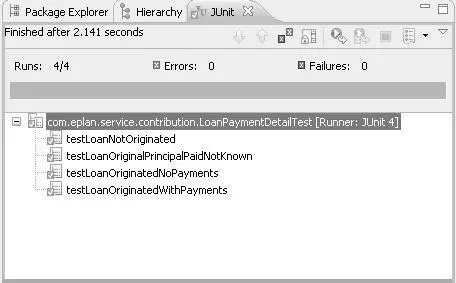Crispin, Lisa - Agile Testing - A Practical Guide for Testers and Agile Teams
Здесь есть возможность читать онлайн «Crispin, Lisa - Agile Testing - A Practical Guide for Testers and Agile Teams» весь текст электронной книги совершенно бесплатно (целиком полную версию без сокращений). В некоторых случаях можно слушать аудио, скачать через торрент в формате fb2 и присутствует краткое содержание. Год выпуска: 2008, Издательство: Addison-Wesley Professional, Жанр: Старинная литература, на английском языке. Описание произведения, (предисловие) а так же отзывы посетителей доступны на портале библиотеки ЛибКат.
- Название:Agile Testing: A Practical Guide for Testers and Agile Teams
- Автор:
- Издательство:Addison-Wesley Professional
- Жанр:
- Год:2008
- ISBN:нет данных
- Рейтинг книги:4 / 5. Голосов: 1
-
Избранное:Добавить в избранное
- Отзывы:
-
Ваша оценка:
- 80
- 1
- 2
- 3
- 4
- 5
Agile Testing: A Practical Guide for Testers and Agile Teams: краткое содержание, описание и аннотация
Предлагаем к чтению аннотацию, описание, краткое содержание или предисловие (зависит от того, что написал сам автор книги «Agile Testing: A Practical Guide for Testers and Agile Teams»). Если вы не нашли необходимую информацию о книге — напишите в комментариях, мы постараемся отыскать её.
Agile Testing: A Practical Guide for Testers and Agile Teams — читать онлайн бесплатно полную книгу (весь текст) целиком
Ниже представлен текст книги, разбитый по страницам. Система сохранения места последней прочитанной страницы, позволяет с удобством читать онлайн бесплатно книгу «Agile Testing: A Practical Guide for Testers and Agile Teams», без необходимости каждый раз заново искать на чём Вы остановились. Поставьте закладку, и сможете в любой момент перейти на страницу, на которой закончили чтение.
Интервал:
Закладка:
Janet’s Story
Lisa and I made a great team; each of us had our own strengths. When one of us faltered and took some time to recoup, the other picked up the slack. I learned so much from Lisa (thanks go to her for giving me this opportunity), but I also found I learned a lot from myself. Just the process of articulating my thoughts helped to clarify things that had been rumbling around in my brain for a long time. The mindmaps helped immensely, so thanks to Kenji Hiranabe, who gave a workshop at Agile 2007 and made me realize what a powerful yet simple tool mind maps can be.
This book-writing journey was an amazing experience. Thanks to the people on all the teams I worked with who provided so many of the examples in this book.
It’s been a pretty special year all the way around. During the year (or so) it took to write this book, my family increased in size. My two daughters, Dana and Susan, each gave me a grandson—those were some of the times Lisa picked up the slack. I would like to thank my granddaughter Lauren (currently three) for making me leave my computer and play. It kept me sane. Thanks to my sister Colleen who gave me long-distance encouragement many mornings using instant messenger when I was feeling overwhelmed with the sheer number of hours I was putting in.
And a very special thanks to Jack, my husband, who moved his office downstairs when I took over the existing one. There were times when I am sure he felt neglected and wondered if he even had a wife as he spend many long hours alone. However, he was there with me the whole way, encouraging and supporting me in this endeavor. —Janet
About the Authors
Lisa Crispinis an agile testing practitioner and coach. She specializes in showing testers and agile teams how testers can add value and how to guide development with business-facing tests. Her mission is to bring agile joy to the software testing world and testing joy to the agile development world. Lisa joined her first agile team in 2000, having enjoyed many years working as a programmer, analyst, tester, and QA director. Since 2003, she’s been a tester on a Scrum/XP team at ePlan Services, Inc. She frequently leads tutorials and workshops on agile testing at conferences in North America and Europe. Lisa regularly contributes articles about agile testing to publications such as Better Software magazine, IEEE Software , and Methods and Tools . Lisa also co-authored Testing Extreme Programming (Addison-Wesley, 2002) with Tip House.
For more about Lisa’s work, visit her websites, www.lisacrispin.com and www.agiletester.ca, or email her at lisa@agiletester.ca.
Janet Gregoryis the founder of DragonFire Inc., an agile quality process consultancy and training firm. Her passion is helping teams build quality systems. For the past ten years, she has worked as a coach and tester, introducing agile practices into both large and small companies. Her focus is working with business users and testers to understand their role in agile projects. Janet’s programming background is a definite plus when she partners with developers on her agile teams to implement innovative agile test automation solutions. Janet is a frequent speaker at agile and testing software conferences, and she is a major contributor to the North American agile testing community.
For more about Janet’s work, visit her websites at www.janetgregory.ca, www.janetgregory.blogspot.com, and www.agiletester.ca, or you can email her at janet@agiletester.ca.
Part I Introduction
In the first two chapters, we provide an overview of agile testing, highlighting how agile testing differs from testing in a traditional phased or “waterfall” approach. We explore the “whole team” approach to quality and testing.
Chapter 1 What Is Agile Testing, Anyway?

Like a lot of terminology, “agile development” and “agile testing” mean different things to different people. In this chapter, we explain our view of agile, which reflects the Agile Manifesto and general principles and values shared by different agile methods. We want to share a common language with you, the reader, so we’ll go over some of our vocabulary. We compare and contrast agile development and testing with the more traditional phased approach. The “whole team” approach promoted by agile development is central to our attitude toward quality and testing, so we also talk about that here.
Agile Values
“Agile” is a buzzword that will probably fall out of use someday and make this book seem obsolete. It’s loaded with different meanings that apply in different circumstances. One way to define “agile development” is to look at the Agile Manifesto (see Figure 1-1).
Figure 1-1 Agile Manifesto

Using the values from the Manifesto to guide us, we strive to deliver small chunks of business value in extremely short release cycles.
We use the word “agile” in this book in a broad sense. Whether your team is practicing a particular agile method, such as Scrum, XP, Crystal, DSDM, or FDD, to name a few, or just adopting whatever principles and practices make sense for your situation, you should be able to apply the ideas in this book. If you’re delivering value to the business in a timely manner with high-quality software, and your team continually strives to improve, you’ll find useful information here. At the same time, there are particular agile practices we feel are crucial to any team’s success. We’ll talk about these throughout the book.
Chapter 21, “Key Success Factors,” lists key success factors for agile testing.
What Do We Mean by “Agile Testing”?
You might have noticed that we use the term “tester” to describe a person whose main activities revolve around testing and quality assurance. You’ll also see that we often use the word “programmer” to describe a person whose main activities revolve around writing production code. We don’t intend that these terms sound narrow or insignificant. Programmers do more than turn a specification into a program. We don’t call them “developers,” because everyone involved in delivering software is a developer. Testers do more than perform “testing tasks.” Each agile team member is focused on delivering a high-quality product that provides business value. Agile testers work to ensure that their team delivers the quality their customers need. We use the terms “programmer” and “tester” for convenience.
Several core practices used by agile teams relate to testing. Agile programmers use test-driven development (TDD), also called test-driven design, to write quality production code. With TDD, the programmer writes a test for a tiny bit of functionality, sees it fail, writes the code that makes it pass, and then moves on to the next tiny bit of functionality. Programmers also write code integration tests to make sure the small units of code work together as intended. This essential practice has been adopted by many teams, even those that don’t call themselves “agile,” because it’s just a smart way to think through your software design and prevent defects. Figure 1-2 shows a sample unit test result that a programmer might see.
Figure 1-2 Sample unit test output

Интервал:
Закладка:
Похожие книги на «Agile Testing: A Practical Guide for Testers and Agile Teams»
Представляем Вашему вниманию похожие книги на «Agile Testing: A Practical Guide for Testers and Agile Teams» списком для выбора. Мы отобрали схожую по названию и смыслу литературу в надежде предоставить читателям больше вариантов отыскать новые, интересные, ещё непрочитанные произведения.
Обсуждение, отзывы о книге «Agile Testing: A Practical Guide for Testers and Agile Teams» и просто собственные мнения читателей. Оставьте ваши комментарии, напишите, что Вы думаете о произведении, его смысле или главных героях. Укажите что конкретно понравилось, а что нет, и почему Вы так считаете.












